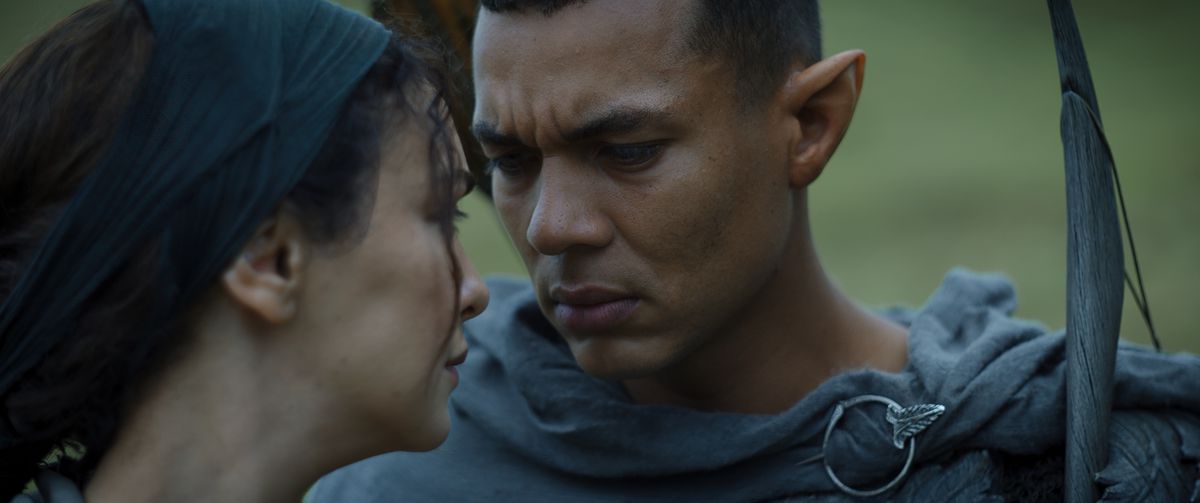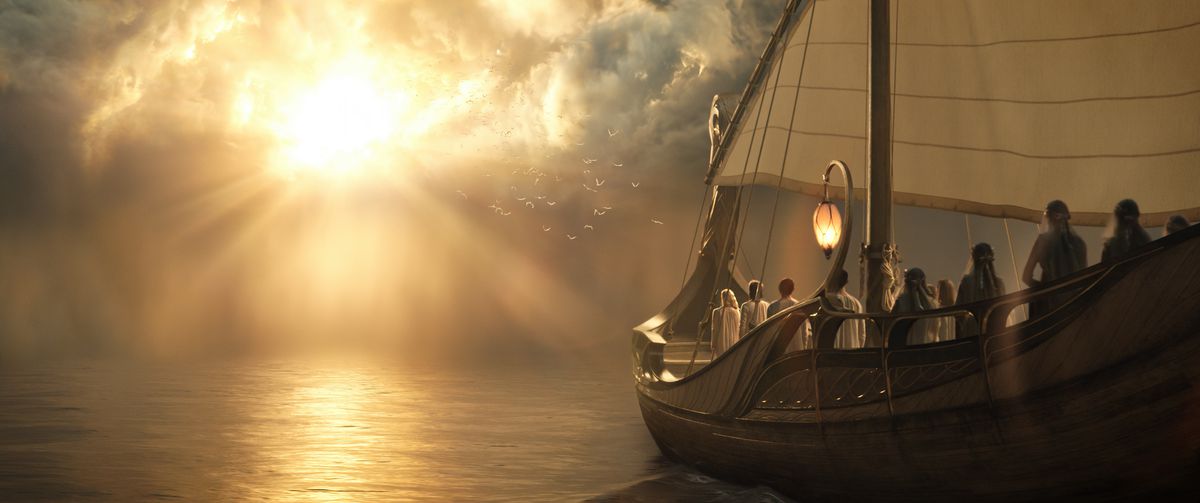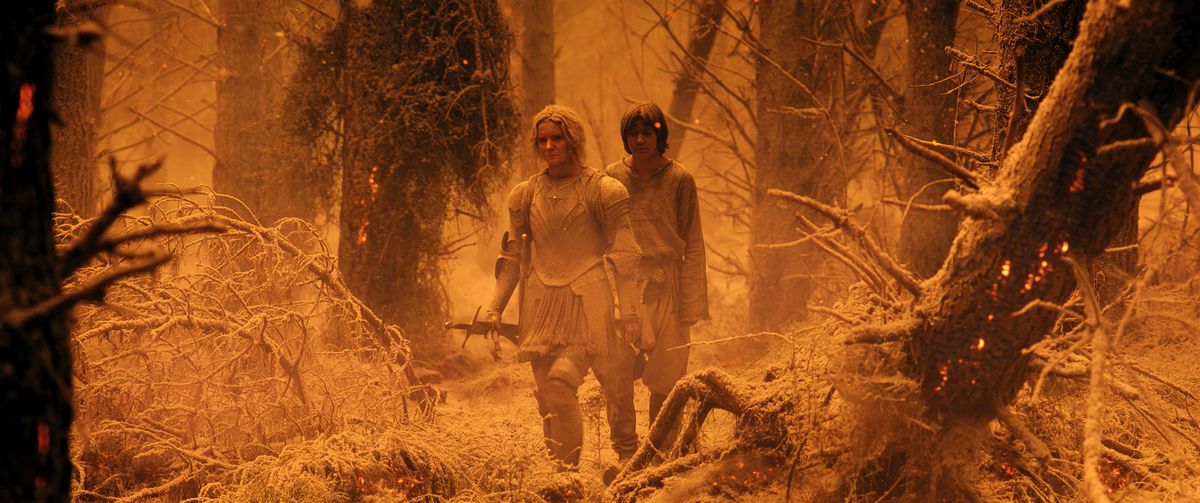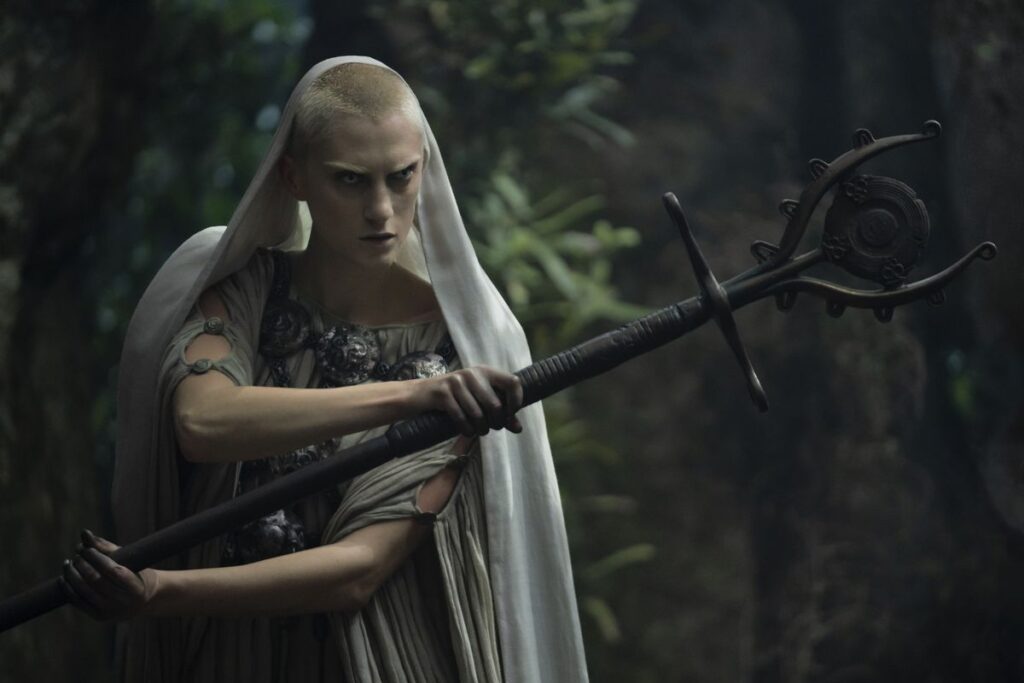When George Lucas, that saucy minx, decided in April 1981 to make the smallest of tweaks to his massive hit film Star Wars, he inadvertently lit a fuse that would burn into a raging culture war to this day. Adding the subtitle Episode IV – A New Hope immediately recontextualized everything that had come and would come in the future, suggesting a grand plan that even a cursory skim of the original trilogy’s production history would reveal to be largely bluster. However, 18 years later, Lucas would have a plan he mostly followed to a T: the prequel trilogy, which has spent most of its existence defined by its failure to live up to its predecessor. There is a lesson in this: Great art pretends to have a plan. Lousy art often suffers from too many plans.
Like with a lot of big shows with huge stakes riding on them, the creators of The Lord of the Rings: The Rings of Power wanted to assure its audience that a plan was in place. So far so good: It is often beneficial for good art to assert that there is a plan it does not have, and for lousy art to insist its plan will work.
The Rings of Power showrunners J.D. Payne and Patrick McKay are very vocal about their plan: what, precisely, they are adapting from J.R.R. Tolkien’s Middle-earth legendarium and how long it would take to do it. As of this moment, the plan is roughly to show the lead-up to the prologue of Peter Jackson’s The Fellowship of the Ring, to end their new opus right where the former one began. Unfortunately, that plan is becoming less exciting in its execution.
The Rings of Power has built itself around mysteries that neither Tolkien, nor his most famous adaptors, ever bothered with. The driving forces behind the first season all revolve around identities obscured by the writers, not deep desires of the characters. Thus its biggest questions are ones the show poses to the audience: Who is the Stranger? How about Sauron? Or Adar?
Photo: Ben Rothstein/Prime Video
The Lord of the Rings and its related works were never really concerned with mysteries; most characters were who they appeared to be and few had much to hide. Some were not what other characters expected them to be, but the audience is always clued in — Aragorn, for example, is not who many in the story expect him to be, but from the moment the audience finds out about his broken sword, the implication is clear: He is Isildur’s heir, the king of Gondor who does the titular returning in The Return of the King.
This is the strength of Tolkien’s brand of high fantasy, and ironically the same reason it is rejected by more modern takes on the genre. It’s why Rings of Power can exist comfortably alongside House of the Dragon and still feel like an entirely different experience — because it is. It’s a world where archetypal characters wrestle with abstractions that represent good and evil in the purest of terms, where the darkness is abyssal and the light that burns to beat it back is faint but burns hot. It’s never really a question if people like the elven king Gil-galad or renowned genius Celebrimbor are good or evil, it’s just whether or not they’re misguided in their noble ideals. Characters in Middle-earth go on journeys that will lead them to one side or another: the growing ranks of those who fight for the light, or the masses that give in to despair.
Because of this, so much of Tolkien’s work is about incredible journeys, of great distances crossed and struggles endured to an impossible destination. Perhaps the biggest reason why The Rings of Power falls short in its first season is also the simplest: It’s not headed anywhere.

Image: Prime Video

Image: Prime Video
Sure, people travel. Faced by the threat of orcs led by the mysterious Adar, Bronwyn and the denizens of the Southlands are constantly fleeing for safety. Galadriel, who begins her story on her way to the elf heaven of Valinor, decides at the last moment to turn down paradise in order to continue her hunt for Sauron in Middle-earth. Elrond goes back and forth to Khazad-dûm. The island kingdom of Númenor, long isolated under a policy of noninterventionism, finally sends soldiers out into Middle-earth proper, an act that will be the beginning of its downfall.
None of these trips, however, are journeys, not in the Campbellian sense. And this, I would argue, is a big part of why The Rings of Power may feel so hollow: So few of its characters grow. This is a shame, because there are relationships here worth seeing through, and the best moments in the series are generally when those relationships are given room to play out: namely, between Durin the dwarven prince and his wife, father, and Elrond. This is why it’s so deflating that most other characters are reduced to simply learning the hidden roles dealt out in the secret game of Werewolf the writers have been playing. Galadriel’s history with her husband, Bronwyn’s plight in the Southlands with her son Theo, absolutely everything about the harfoots — all of it reduced to parlor room debate over who might be holding the card that says they’re the Dark Lord.
Galadriel, the ostensible protagonist of the series, is the same person at the end of season 1 that she was at the start; the only appreciable difference by the season finale is one she shares with most of the big players in The Rings of Power: A bunch of characters that projected competence now look like huge dopes. The finale’s revelation of Sauron’s identity is depicted in a way that mostly unfolds for the viewer’s benefit, as those who learn the truth are fooled because they are made to be less observant, less active, and more trusting of a character that is essentially dropped into their story at a climactic moment without good reason to be there.
Photo: Ben Rothstein/Prime Video
Preamble continually supersedes character on The Rings of Power. The distance between where characters must be in the showrunners’ endgame plans and where they are now serves as justification for their present decisions, not character development. Why are Bronwyn and Arondir attracted to one another, and pulled into each other’s orbit? Why do Elendil and Queen Regent Míriel suddenly have a connection? Why do the elves, after learning of Sauron’s identity, still use his ideas?
There’s an easy answer for this: It’s all part of the plan, and it’ll make sense if we stick along. But good plans, and good television, do not place all of their bets on things working out their way in the end. The present ought to matter infinitely more, as a worthwhile journey is what ultimately guarantees we reach our destination.
Ironically, The Rings of Power has so many things to show us. Dwarven halls, human navies, elven woods. All of it beautiful. The virtually unlimited budget the series has never failed when it comes to sights and texture. This is a Middle-earth that people live in, that a viewer would want to visit, that would be a tragedy were it to face destruction. However, it’s constructed with the architecture of a video game, with prominent sightlines that draw attention to what lies on the horizon, dramatic establishing shots so the viewer does not forget the majesty of the fantasy cities they visit, and thoughtful costuming that tells you where every person is from. Perhaps it is no mistake that it is more interesting to imagine oneself in this version of Middle-earth’s Second Age than it is to conjure the inner lives of any of the characters The Rings of Power populates it with.

Image: Prime Video

Image: Prime Video

Image: Prime Video
The Rings of Power is the work of mapmakers, not storytellers. Maps are, after all, works of hubris: You can only make one if you are foolish enough to believe the world is known. Yet most of the most memorable moments in the grand story of Middle-earth lie in what is not shown in the map that precedes Tolkien’s work. The things that happen in Mirkwood, the haunted halls of Moria, the fields of Rohan. Whose stories diverge or end there, and how they are changed afterward. Something is moving these characters to travel, whether it is treasure or adventure or simply a deep desire to do the right thing, because someone must.
Perhaps the best thing that could happen to The Rings of Power is if it stopped mapping this world in such painstaking detail, and instead simply traveled it with us.
Season 1 of The Lord of the Rings: The Rings of Power is now streaming on Amazon Prime Video.

